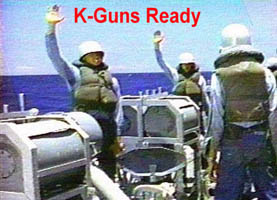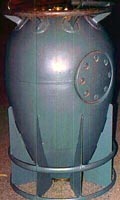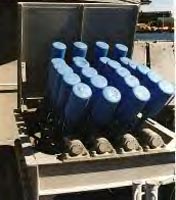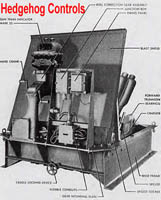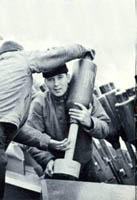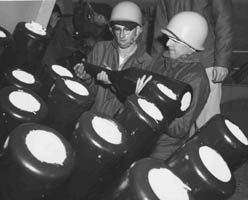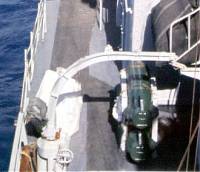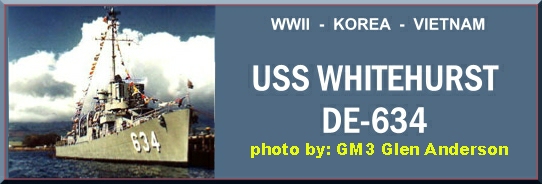
USS Whitehurst Logo by: Pat Stephens, Webmaster, DESA
|
USS Whitehurst DE-634 Anti Submarine Warfare Armament |
|
| When launched in 1943, Whitehurst had two classes of ASW weapons. These were "Depth Charges" and "Hedgehogs". Depth charges had a pressure sensitive detonator which was set to a specific depth just before the charges were to be used. Sonarmen, listening to their sound gear would try to predict where the submarine target would be so that proper depth settings could be dialed into the detonators. Every charge exploded at the depth dialed in. Individual hedgehogs would explode if they made contact with a target, however if one exploded, it set off all the others. In 1956 the "smart" Mk32 Homing Torpedoes and Launchers were installed on each quarterdeck. In the 1960s later models were delivered to the ship but never installed. | |
|
Depth Charges |
|
|
|
|
| "Ash Cans" in D C Racks. Starboard Rack removed in the 60s MK6 Charges in the K-Guns | |
| The "K-Guns Ready" photo is a still shot captured from the Video of the Movie, "The Enemy Below" which was filmed aboard Whitehurst in 1957. The sailor on the left is Seaman First class Jackie Barton who hailed from Phoenix, AZ. Jackie if you see this, get in touch. Max Crow Yeoman USS Whitehurst Assn | |
|
|
|
|
The older depth charges shown in
left photo had a
"sink rate" of 8-12 fps compared to 14 - 20 fps for the Tear
Drop model. The left photo show the depth charge chained to its T-shaped
arbor. The leg of the of the arbor is inside the barrel of the
K-Gun. Just above the base of the gun is the round expansion
chamber. The breech of the gun us covered by a bonnet which is held in
place by a bail with a T-screw. The depth charges are propelled outward
by "Impulse Charges" which were simply gun powder in a brass
shell cases that were approximately 3" x 8". The K-Guns could be
fired electrically from push buttons, mounted on the starboard side of the Fire
Control shack on the bridge, or by pulling a lanyard on the K-Gun. Depth
Charges on the racks could be released from the bridge or by a manually operated
lever on the rack. |
|
|
Hedgehogs, Forward Thrown ASW Weapons |
|
|
|
|
|
|
|
| Lower photos taken on Whitehurst during 1959 Reservist Training Cruise. In right photo the man wearing glasses Rodger Clement, is now a retired Master Chief. In the photo on the left, the loader is carefully accepting a Hedgehog round which he will gently slide onto the spigot. The man on the left has his right hand on the protective cap. Before launch, the caps will be removed to expose detonators. Notice how carefully the charges are handled. Imagine it in rough, wet weather on a pitching, rolling deck. | |
|
The Hedgehogs were loaded onto spigots in a 4 x 6 pattern
pointing forward at slightly different angles. Each spigot had a firing
pin which touched the cap of a small charge. The hollow mounting
tube and the charge constituted a rocket assembly which fired the bomb portion
of the weapon into the air. Twenty-four Hedgehogs were electrically fired
in rapid succession so that they sank toward the target in a 3 dimensional
pattern. At his station behind the shield, the operator, turning the
hand crank, matched pointers on a dial which responded to signals from the
Sonar Control Room on the face of the bridge superstructure. This action
tilted the bed of the launcher so that the Hedgehogs could be fired within an
arc that extended several degrees left and right of "dead
ahead". Whitehurst was built with one launcher mounted on the
main deck directly aft of Mount 31. In 1956, this launcher was removed and
two launchers were installed on the 01 level on either side and slightly aft of
Mount 32. |
|
|
Mk32 "Smart" Torpedoes |
|
|
|
|
|
Left photo shows one of the first Mk32 Torpedoes. You can see a more comprehensive story at |
|
| Photo on right was taken from the Whitehurst's starboard signal bridge looking aft. The Torpedoes are green and are stored inboard. The white launcher is visible on the deck near the lifelines. Torpedo in the left photo is on the launcher. The special davit, used to move the torpedo from storage to the launcher is clearly visible in both photos. | |
|
Comments
of Tim Dorgan SM2 who served on Whitehurst
in the ‘50s “I was fascinated by the launchers for the
torpedoes we had. They were two, pneumatically operated, rocker arms like the letter j and they flipped the
torpedoes over the rail and over the side. They were launched butt forward and
the movement when they hit the water would twist the propellers backward, this
would fire the propulsion unit and the torpedo would take off on its hunt. I
only got to watch one test launch with a dummy torpedo but it must have been one
hell of an ASW weapon for its day.” |
|
WWII
Era | Korea War &
'50s | Viet Nam & 60s |
Reunions |
All Links Page |
Search & Rescue
Memorial |
Poetry |
Enemy Below |
Taps List |
Photos/Armament |
History |
Crews Index |
Home

